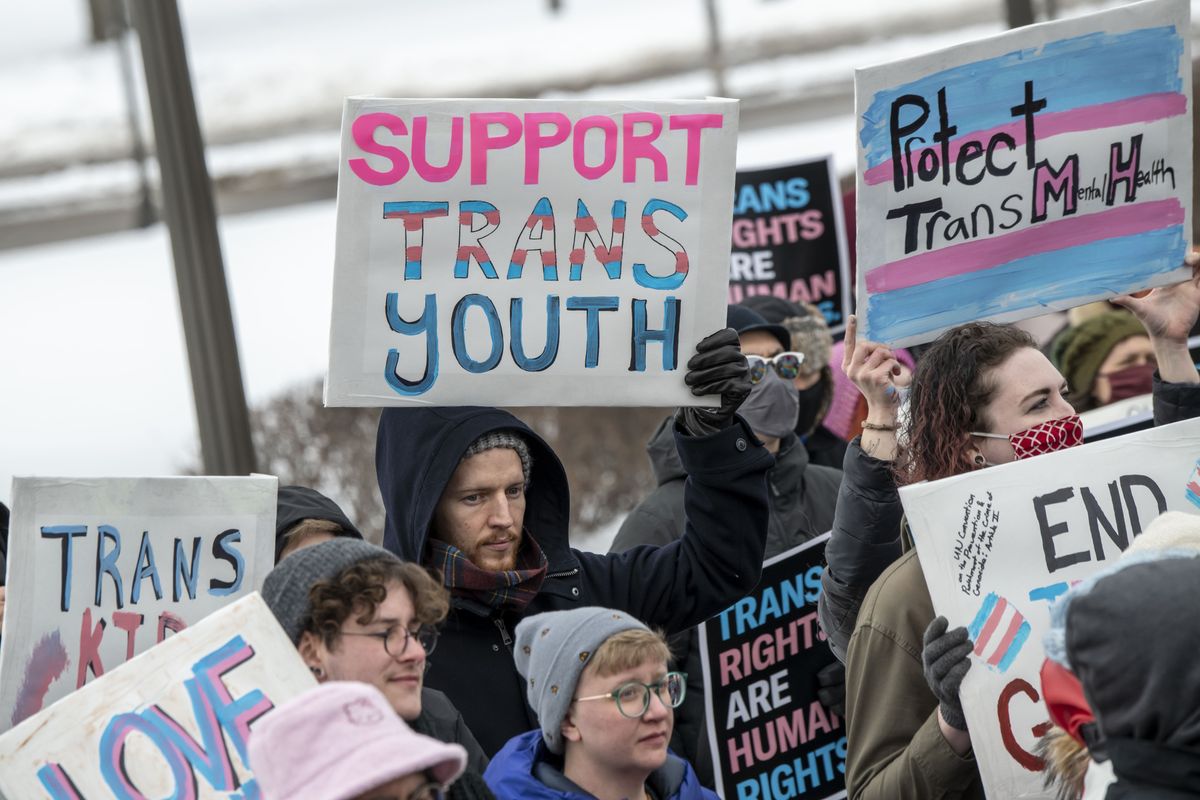
In a letter to New York Times leadership (2/15/23), more than 180 of the paper’s contributors (later swelling to more than 1,000) raised “serious concerns about editorial bias in the newspaper’s reporting on transgender, non-binary and gender nonconforming people.” What started as a conversation about a paper’s coverage exploded into a battle between media workers who see a problem at one of the most powerful media outlets on earth, and a media management that simply won’t listen.
“Some of us are trans, non-binary, or gender nonconforming, and we resent the fact that our work, but not our person, is good enough for the paper of record,” the letter declared:
Some of us are cis, and we have seen those we love discover and fight for their true selves, often swimming upstream against currents of bigotry and pseudoscience fomented by the kind of coverage we here protest.The letter was organized by the Freelance Solidarity Project, a part of the National Writers Union.
A similar letter from LGBTQ media advocacy group GLAAD (2/15/23) and over a hundred other LGBTQ groups and leaders made three demands (summarized in a press release):
- Stop printing biased anti-trans stories, immediately.
- Listen to trans people: hold a meeting with trans community leaders within two months.
- Hire at least four trans writers and editors within three months.
As FAIR (1/6/23) and many other progressive outlets and groups have noted, there is a campaign in state legislatures, in the courts, in the streets and in the media to roll back rights for transgender people, fomenting a moral panic about teachers and drag queens coming for America’s children. States like Florida are already banning certain types of medical care for trans people (Tampa Bay Times, 2/10/23), and other states have enacted similar laws (NBC, 2/14/23). States are even looking to restrict drag performances (Washington Post, 2/14/23).
This campaign is often portrayed as coming from the far right, which sees traditional gender roles under attack by a new world order. But liberal and centrist institutions like the New York Times aid and abet this campaign.
‘Patient zero’
Invoking the Times’ early homophobic response to the rise of the gay rights movement and the AIDS crisis, the letter writers argue that the paper has a responsibility to do better. The contributors’ letter cites an article (6/15/22) that
uncritically used the term “patient zero” to refer to a trans child seeking gender-affirming care, a phrase that vilifies transness as a disease to be feared.The article quoted “multiple expert sources who have since expressed regret over their work’s misrepresentation.” (FAIR and the podcast Death Panel, among others, have detailed many other problems with the article).
The letter points to another piece (1/22/23) about children’s right to safely transition and policies about whether schools can or should withhold students’ gender transitions from their parents. The piece, the letter says, “fails to make clear that court cases brought by parents who want schools to out their trans children are part of a legal strategy pursued by anti-trans hate groups,” which have “identified trans people as an ‘existential threat to society’ and seek to replace the American public education system with Christian homeschooling,” noting that this is “key context” that was not provided to Times readers.
The articles cited in the letter give the impression that we are living in a time of rushed, ill-informed transitions and shady treatments for children that lack oversight. As Samantha Hancox-Li wrote (Liberal Currents, 2/8/23), this is, in fact, the opposite of the truth, because cisgender minors have easier access to treatments they need than trans youth:
This is the reality of trans care in the United States: not children being rushed to experimental treatments, but explicit segregation, discrimination and the denial of basic care. When a trans kid wants to grow out her hair and change her name, it’s national news. When a cis kid wants to do the same thing, it’s Tuesday. When trans kids want hormone replacement therapy, we call it “gender-confirming treatments” and publish article after fretting article about how strange and dangerous they are. When cis kids receive medically identical prescriptions, it’s Tuesday. We don’t even have a name for it. Because what’s normal is invisible.The question before us isn’t whether we should allow trans kids access to special experimental treatments. The question is whether we enable trans kids to access essential medical care on the same terms we allow cis kids to.
Gender-affirming care is critical because it has been shown to have enormous mental health benefits for trans youth, including reducing the risk of suicide (JAMA, 2/25/22; Scientific American, 5/12/22).
Misrepresenting facts
The letter writers note that the coverage of trans issues has fed into the assault on trans rights at the state level. GLAAD said in its letter:
Every major medical association supports gender-affirming care as best-practices care that is safe and lifesaving and has widespread consensus in the medical and scientific communities. Yet the Times continues to churn out pieces that anti-trans extremists use to harm children and families. In November, the Times published a story that got the science of gender-affirming care so wrong that the WPATH had to write a multi-page tear-down explaining how the Times misrepresented the facts at every turn.The letters’ examples are far from exhaustive. For instance, columnist Pamela Paul—once again, no relation—regularly uses the platform the Times gives her to spread misleading anti-trans narratives, as FAIR (12/16/22) has documented.
In perhaps the clearest display of out-of-touch-ness, the day after the letter went public, the Times published a column by Paul (2/16/23) defending author J.K. Rowling—who has immense literary fame and cultural power—from charges of transphobia, quoting one advocate saying Rowling “sees herself as standing up for the rights of a vulnerable group.” The vulnerable group here isn’t one of the world’s most marginalized minorities, but people like Rowling who want “spaces for biological women only.” Paul invoked the stabbing of Salman Rushdie in deeming criticism of Rowling “dangerous.”
Rowling has been an outspoken opponent of Scotland’s attempt to enact legislation to protect trans rights (BBC, 10/7/22), which was eventually blocked by the British prime minister (Guardian, 1/16/23). That defeat helped lead to the Scottish first minister’s resignation, which was celebrated by conservative British media (Economist, 2/15/23; Daily Mail, 2/15/23; London Times, 2/16/23).
In other words, Rowling isn’t just saying things trans people don’t like, she’s actively impeding social progress and helping to end the careers of politicians who offend the established order. Paul’s advocacy for Rowling is a reversal of journalism’s mission: She afflicts the afflicted and comforts the comfortable.
Pushed to the margins
Keep in mind, the contributors’ letter isn’t saying that certain viewpoints should be censored because they are offensive or right-wing. The push for the New York Times to keep a skeptical eye on the agenda of resisters of social progress isn’t censorship or anti-free speech. It is saying that trans issues have not been reported on accurately or fairly. That is a discussion that should happen more often in the mediasphere on a whole host of topics.
“It’s really a question of emphasis and resources,” FSP organizing committee member Eric Thurm told FAIR. “The pieces that take the ‘just asking questions’ approach are A1 cover stories, while others are pushed to the margins.”
There’s another important aspect of this letter: It comes from freelancers organized by the FSP, not staffers who have a regular paycheck or longevity at the paper. For freelancers, openly criticizing the editors of a major outlet is a real risk, because it might mean no more commissions in the future. This kind of precarity in journalism has long been denounced as cost-cutting—contractors are just cheaper and more expendable than NewsGuild-represented staff members—but it’s also a good way to enforce ideology at publications, because contractors have far less power to contradict their editors. By banding together publicly, these independent workers are challenging a very important tool corporate media use to manufacture consent.
Letter-signer Steven Thrasher, author of The Viral Underclass and contributor to Scientific American, told FAIR that writers are confronting the “most influential newspaper in the English-speaking world about its trans coverage; it’s not above critique.” Such coverage is “an ungodly amount of pressure being put on such a small percentage of the population.”
Thrasher added, “It’s hard to dismiss this many writers, past and present.”
Declaring war on criticism
Yet dismissing them is exactly what the paper’s leadership has done so far. The paper’s top editor, Joe Kahn, has essentially declared war against the letter—and its signatories. In a memo to staff (Hell Gate, 2/17/23), Kahn characterized the letter as a “protest letter” that “included direct attacks on several of our colleagues, singling them out by name.” “Participation in such a campaign,” Kahn warned, “is against the letter and spirit of our ethics policy.”
Kahn defended the paper’s work without acknowledging or addressing any of the letter’s specific claims, writing, “Our coverage of transgender issues, including the specific pieces singled out for attack, is important, deeply reported, and sensitively written.” He claimed that “any review” of the paper’s coverage “shows that the allegations this group is making are demonstrably false,” without offering any evidence.
Kahn continued:
Even when we don’t agree, constructive criticism from colleagues who care, delivered respectfully and through the right channels, strengthens our report.We do not welcome, and will not tolerate, participation by Times journalists in protests organized by advocacy groups or attacks on colleagues on social media and other public forums.
The writers offered documented criticism, and Kahn dismissed it—prohibited it—as an attack and a protest organized by an outside group. Remember, these are people the Times clearly regards as worthy enough to write for the paper, but not worthy to have an honest discussion with about the paper’s biases. As Thurm said, the response doesn’t engage “substantively with the issues we’re raising.”
National reporter Michael Powell—author of one of the pieces criticized by the letter writers—likewise responded smugly (Twitter, 2/15/23), “Journalism is meant to ask difficult and discomforting questions, and to question institutions, including the medical establishment.” It’s a clever response, in which the real issues brought up in both the FSP and GLAAD letters are pushed aside and reframed as the Times courageously standing up to Big Medicine.
The paper (Mediate, 2/15/23) also publicly responded to the GLAAD letter, contrasting its own “independent reporting” with the “advocacy” goals of GLAAD. The response argued that the Times “strives to explore, interrogate and reflect the experiences, ideas and debates in society… Our reporting did exactly that and we’re proud of it.”
‘A plain old-fashioned newspaper crusade’
The answer to this line of defense is in a piece cited in the letter itself, an essay by Tom Scocca in Popula (1/29/23):
In the past eight months, the Times has now published more than 15,000 words’ worth of front-page stories asking whether care and support for young trans people might be going too far or too fast…. This is pretty obviously—and yet not obviously enough—a plain old-fashioned newspaper crusade. Month after month, story after story, the Times is pouring its attention and resources into the message that there is something seriously concerning about the way young people who identify as trans are receiving care…. The notion that trans youth present a looming problem is demonstrated to the reader by the sheer volume of coverage. If it’s not a problem, why else would it be in the paper?But the Times can never engage in a discussion of why it’s obviously problematizing the issue, because it’s wedded to the fiction that the paper only ever reflects reality—and that its coverage does not shape that reality.
That helps explain why Kahn was so angry in his memo to the staff. You could almost hear him muttering the old War on Terror line, “You’re either with us, or with the terrorists.”
GLAAD (2/15/23) responded, “The Times is not only standing behind coverage that hundreds of leaders in journalism, media and LGBTQ advocacy are speaking out against, but boasting that they are proud of it.”
The paper has taken an “us versus them” attitude in its newsroom. The battle here is more than a debate over trans coverage, but a struggle between workers and media bosses over the narrative. Collective action for media reform, especially from many people with influence in the literary world, is more powerful than individual letters to the editor. And as the letter writers say, this isn’t just about how words appear on the page—the trans community and its allies see this as a necessary action in slowing down the growing assault on trans rights. Let’s hope to see more of this kind of action.
“The Times is on the defensive and the people advocating for trans rights are on the offensive,” Thrasher said. “That’s a good thing.”

 1 year ago
48
1 year ago
48


